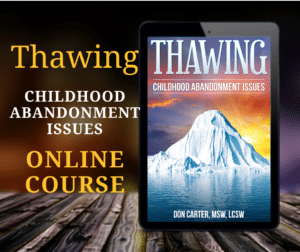
List of Defense Mechanisms
Here we explore a list of defense mechanisms employed by the subconscious mind to ward off anxiety and protect the conscious mind from emotional pain. The amazing ability of the subconscious mind to protect the conscious mind is at the root of many “symptoms” and problem behaviors encountered in counseling, therapy, and personal growth.
Symptoms as Metaphors for Subconscious Conflicts
The subconscious mind is very symbolic and metaphorical. Many professional helpers see symptoms as metaphors…symbolic of the client’s internal experience. These are usually subconscious solutions to internal conflicts such as those outlined in the list of defense mechanisms below.
For example, when a person would like to do one thing, but instead can’t seem to help but do another, it indicates that there’s a conflict between the conscious mind and some part of the subconscious mind… In other words, part-of-me is aware that another part-of-me is doing something of which I don’t consciously approve… something that may even interfere with my goals or needs.
A good example of this is when I consciously determine that I’m going to lose weight and yet I repeatedly fail to stick to my nutritional plan (we don’t like the word “diet”)… I try and try to stick to the plan and feel very upset “with myself” for caving in again!
Another term for such internal conflicts is Cognitive Dissonance — Two cognition’s (elements of knowledge)… usually one conscious and the other subconscious… are in direct conflict with each other. The two opposing cognition’s are located on neural networks in the brain. They create anxiety that steadily intensifies until the subconscious mind employs a solution from its list of defense mechanisms.
List of Defense Mechanisms

- Rationalization – Subconscious justifications, excuses or reasonings given to make a behavior seem logical — “A student fails the final he didn’t study for and says… “I couldn’t have passed it anyway – that teacher has it in for me.” Rationalization is included at the beginning of any list of defense mechanisms because it’s so frequently recognized as “being defensive”.
- Projection – Attempts to banish or “disown” unwanted and disliked thoughts, behaviors, and even “parts of self” by projecting or attributing them to someone else. Maybe as simple as blaming someone else – “He should have let me off on that ticket but that cop was trying to fill his monthly quota.” Or as complex as seeing and experiencing a repressed or “disowned” part of self in another person – e.g., an excessively passive person marries an excessively angry person – both experience their disowned “part” in the other.
- Introjection – The opposite of projection – subconsciously “takes in” to self an imprint (or recording) of another person including all their attitudes, messages, prejudices, expressions, even the sound of their voice, etc. This is healthy if the imprinted material is helpful advice, warnings, or other lessons from parents and respected others — unhealthy if shaming messages from parents, hatred, or aggression is turned inward on self.
- Identification – An ability available very early in life that children use to attach themselves to certain qualities, emotions, and attitudes of someone else…especially during the modeling period between eight and thirteen. This helps the child further develop the Adult Ego State and the Parent Ego State.
- Simple Denial – Unpleasant facts, emotions, or events are treated as if they are not real or don’t exist. — a person told that their spouse was killed in a motor vehicle accident acts as if he/ or she is still alive. (Not consciously lying) Addictive Denial NOTE: Simple denial and addictive denial are similar, but the “denial” associated with addiction is really much more complex than simple denial, because it is referring to an elaborate SYSTEM of defenses that create a delusion for the addict or alcoholic that is OK for them to drink or use drugs even in the face of overwhelming evidence that it is destroying them. Don’s book, Thaw – Freedom from Frozen Feelings, presents a model of the complex set of defenses characteristic of addictive denial…
- Isolation – Separation of memory from emotion…can remember and talk about the trauma but feels no emotion — the Person talks about the incident as if it is someone else’s story which is accomplished by taking Third Perceptual Position.
- Sublimation – Redirection of impulses into socially acceptable activities — normal and healthy, such as when the sexual impulses of adolescence is channeled into sports and competition.
- Displacement – No list of defense mechanisms would be complete without displacement. This defense reduces anxiety or pressure by transferring feelings toward one person to another — commonly known as “dumping on” someone…e.g., man is mad his boss and kicks the cat when he gets home, or blows up and yells at his family.
- Repression – Painful, frightening, or threatening emotions, memories, impulses or drives that are subconsciously pushed or “stuffed” deep inside. It takes a lot of energy to keep material “stuffed”…energy that could be used for more productive living. Healthy if the person does not have the psychological defenses available to deal with it.
- Suppression – Painful, frightening, or threatening emotions, memories, impulses or drives that are consciously pushed or “stuffed” inside as a defensive maneuver. Again, it takes a lot of energy to keep material “stuffed”.
- Conversion – Mental conflict converted to a physical symptom… e.g., a soldier on being deployed into battle is conflicted about his desire to serve his country but believes it is wrong to kill for any reason develops paralysis, blindness, or deafness with no medical cause.
- Regression – Giving up the current level of development and going back to a prior level… and older child under stress begins wetting the bed or sucking a thumb after a long period without that behavior. In extreme cases of PTSD, an adult could regress into a child-like ego-state and curl up in a fetal position on the floor unable to communicate.
- Reaction Formation – Over-compensation for fear of the opposite. Two conflicting parts of self — one is strengthened while the other is repressed…e.g., An overly nice and agreeable person may have a lot of repressed hostility and rage of which they are completely unaware on a conscious level.
- Fantasy – Imagining being
a superhero, winning the Olympic gold medal or Retreating into a dream world of times past. Fantasy can be unhealthy if it happens when action is required instead. Healthy when used to go back and finish the unfinished business of the past or simply for sentiment and nostalgia such as exploring high school yearbook or family album. Fantasy is so commonly experienced that many people forget to include it on their list of defense mechanisms.





